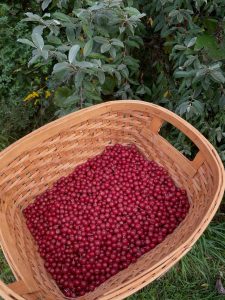Should you find yourself walking through a conifer forest in late summer or autumn, keep your eyes open for a splash of dark orange or red on the ground–it’s lobster mushroom season! The surface often has a crusty texture, like a lobster’s shell, and the concave cap can be quite twisted and warped. But cut it open, and it will be white inside. Adding to its “lobster” characteristics, the smell and taste may be reminiscent of seafood.

Weird Science
The lobster mushroom isn’t just a single fungus–it’s one fungus parasitizing another! More specifically, the host mushroom is a member of the genera Lactarius or Russula (commonly Russula brevipes) which has been parasitized by Hypomyces lactifluorum. The white is the host mushroom, and the red is the Hypomyces.
The gills no longer resemble the delicate structures of Russula or Lactarius, and instead are thicker and chunkier, similar to the false gills of chanterelles. Hypomyces hijacks the gills to spread its own spores. Another way Hypomyces affects its host’s flesh is by making it much firmer, one of the reasons it is prized as a culinary mushroom.
If you’re concerned about Hypomyces infecting an inedible mushroom, fear not: there haven’t been any reports of poisoning from lobster mushrooms due to the host. Hypomyces alters the DNA and metabolites of the mushroom so that almost nothing of the host’s remains, and the bulk of traceable molecules are from the parasite. The metabolites specifically affect the flavor of the mushroom, hence why lobster mushrooms don’t taste like the host.

Where the Lobsters Are
Lobster mushrooms are primarily North American phenomenon. They’re found from extreme southern Canada all through Mexico, though some may be found in northern countries in Central America. In the United States they’re common east of the Great Plains, along the west coast, and in the southeast and northern reaches of the Rockies. Look for trees that have mycorrhizal relationships with the host mushrooms, especially Russula brevipes; conifers such as hemlocks, firs, pines, and spruce trees are common partners. Like other mycorrhizal mushrooms, you’re more likely to find them in less disturbed areas where the forest ecosystem is more complete and biodiverse, as opposed to next to a lone pine or fir in a suburban yard.
July to October is generally the prime time, though in some places they may be found several weeks earlier or later than that time period. Check for them especially after a good rain.
Be careful not to pick unparasitized host mushrooms unless you know they’re edible on their own. The infection only takes a few days to completely cover the host, so if you are concerned about an inedible host, only pick lobster mushrooms that are thoroughly covered in red or orange Hypomyces. There are very rare lobster mushrooms that remain white even as the crusty texture of Hypomyces advances. Some of these are just partly infected, and will turn darker with a little more time, but others remain white even when infection is complete. They are reportedly safe to eat, but it’s okay if you feel safer sticking to the orange and red ones. Just avoid those that are past their prime; their color is often a darker purple-red and they smell like spoiled seafood, and they have a mushier texture.
Because lobster mushrooms are so unique looking, they really don’t have any lookalikes. There are other parasitic Hypomyces species that have the same tactic of overgrowing their host, but they tend to be different colors such as green or white, and not all of them attack the same host species.
Cooking Lobster Mushrooms
While some sources say lobster mushrooms are edible raw, it’s generally a good rule to always cook wild mushrooms to increase digestibility. Because lobster mushrooms have such a firm texture, they need to be cooked longer. They lend themselves well to soups and sautees, but can also be fried or boiled beforehand to help “pre-cook” them. They are a good, if mild, vegan alternative to seafood because of their flavor and texture. They can be preserved by dehydration or freezing.

—————
Written by Rebecca Lexa
Rebecca Lexa is a certified Master Naturalist in the Pacific Northwest. She teaches classes on foraging and other natural history topics, both online and off. More about her work can be found at http://www.rebeccalexa.com.
Many of our readers find that subscribing to Eat The Planet is the best way to make sure they don't miss any of our valuable information about wild edibles.
See our privacy policy for more information about ads on this site






